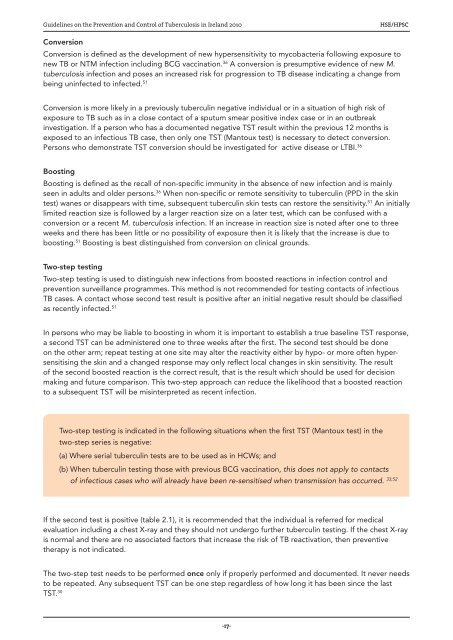Guidelines on the Prevention and Control of Tuberculosis in Ireland
Guidelines on the Prevention and Control of Tuberculosis in Ireland
Guidelines on the Prevention and Control of Tuberculosis in Ireland
You also want an ePaper? Increase the reach of your titles
YUMPU automatically turns print PDFs into web optimized ePapers that Google loves.
<str<strong>on</strong>g>Guidel<strong>in</strong>es</str<strong>on</strong>g> <strong>on</strong> <strong>the</strong> Preventi<strong>on</strong> <strong>and</strong> C<strong>on</strong>trol <strong>of</strong> <strong>Tuberculosis</strong> <strong>in</strong> Irel<strong>and</strong> 2010HSE/HPSCC<strong>on</strong>versi<strong>on</strong>C<strong>on</strong>versi<strong>on</strong> is def<strong>in</strong>ed as <strong>the</strong> development <strong>of</strong> new hypersensitivity to mycobacteria follow<strong>in</strong>g exposure t<strong>on</strong>ew TB or NTM <strong>in</strong>fecti<strong>on</strong> <strong>in</strong>clud<strong>in</strong>g BCG vacc<strong>in</strong>ati<strong>on</strong>. 36 A c<strong>on</strong>versi<strong>on</strong> is presumptive evidence <strong>of</strong> new M.tuberculosis <strong>in</strong>fecti<strong>on</strong> <strong>and</strong> poses an <strong>in</strong>creased risk for progressi<strong>on</strong> to TB disease <strong>in</strong>dicat<strong>in</strong>g a change frombe<strong>in</strong>g un<strong>in</strong>fected to <strong>in</strong>fected. 51C<strong>on</strong>versi<strong>on</strong> is more likely <strong>in</strong> a previously tubercul<strong>in</strong> negative <strong>in</strong>dividual or <strong>in</strong> a situati<strong>on</strong> <strong>of</strong> high risk <strong>of</strong>exposure to TB such as <strong>in</strong> a close c<strong>on</strong>tact <strong>of</strong> a sputum smear positive <strong>in</strong>dex case or <strong>in</strong> an outbreak<strong>in</strong>vestigati<strong>on</strong>. If a pers<strong>on</strong> who has a documented negative TST result with<strong>in</strong> <strong>the</strong> previous 12 m<strong>on</strong>ths isexposed to an <strong>in</strong>fectious TB case, <strong>the</strong>n <strong>on</strong>ly <strong>on</strong>e TST (Mantoux test) is necessary to detect c<strong>on</strong>versi<strong>on</strong>.Pers<strong>on</strong>s who dem<strong>on</strong>strate TST c<strong>on</strong>versi<strong>on</strong> should be <strong>in</strong>vestigated for active disease or LTBI. 36Boost<strong>in</strong>gBoost<strong>in</strong>g is def<strong>in</strong>ed as <strong>the</strong> recall <strong>of</strong> n<strong>on</strong>-specific immunity <strong>in</strong> <strong>the</strong> absence <strong>of</strong> new <strong>in</strong>fecti<strong>on</strong> <strong>and</strong> is ma<strong>in</strong>lyseen <strong>in</strong> adults <strong>and</strong> older pers<strong>on</strong>s. 36 When n<strong>on</strong>-specific or remote sensitivity to tubercul<strong>in</strong> (PPD <strong>in</strong> <strong>the</strong> sk<strong>in</strong>test) wanes or disappears with time, subsequent tubercul<strong>in</strong> sk<strong>in</strong> tests can restore <strong>the</strong> sensitivity. 51 An <strong>in</strong>itiallylimited reacti<strong>on</strong> size is followed by a larger reacti<strong>on</strong> size <strong>on</strong> a later test, which can be c<strong>on</strong>fused with ac<strong>on</strong>versi<strong>on</strong> or a recent M. tuberculosis <strong>in</strong>fecti<strong>on</strong>. If an <strong>in</strong>crease <strong>in</strong> reacti<strong>on</strong> size is noted after <strong>on</strong>e to threeweeks <strong>and</strong> <strong>the</strong>re has been little or no possibility <strong>of</strong> exposure <strong>the</strong>n it is likely that <strong>the</strong> <strong>in</strong>crease is due toboost<strong>in</strong>g. 51 Boost<strong>in</strong>g is best dist<strong>in</strong>guished from c<strong>on</strong>versi<strong>on</strong> <strong>on</strong> cl<strong>in</strong>ical grounds.Two-step test<strong>in</strong>gTwo-step test<strong>in</strong>g is used to dist<strong>in</strong>guish new <strong>in</strong>fecti<strong>on</strong>s from boosted reacti<strong>on</strong>s <strong>in</strong> <strong>in</strong>fecti<strong>on</strong> c<strong>on</strong>trol <strong>and</strong>preventi<strong>on</strong> surveillance programmes. This method is not recommended for test<strong>in</strong>g c<strong>on</strong>tacts <strong>of</strong> <strong>in</strong>fectiousTB cases. A c<strong>on</strong>tact whose sec<strong>on</strong>d test result is positive after an <strong>in</strong>itial negative result should be classifiedas recently <strong>in</strong>fected. 51In pers<strong>on</strong>s who may be liable to boost<strong>in</strong>g <strong>in</strong> whom it is important to establish a true basel<strong>in</strong>e TST resp<strong>on</strong>se,a sec<strong>on</strong>d TST can be adm<strong>in</strong>istered <strong>on</strong>e to three weeks after <strong>the</strong> first. The sec<strong>on</strong>d test should be d<strong>on</strong>e<strong>on</strong> <strong>the</strong> o<strong>the</strong>r arm; repeat test<strong>in</strong>g at <strong>on</strong>e site may alter <strong>the</strong> reactivity ei<strong>the</strong>r by hypo- or more <strong>of</strong>ten hypersensitis<strong>in</strong>g<strong>the</strong> sk<strong>in</strong> <strong>and</strong> a changed resp<strong>on</strong>se may <strong>on</strong>ly reflect local changes <strong>in</strong> sk<strong>in</strong> sensitivity. The result<strong>of</strong> <strong>the</strong> sec<strong>on</strong>d boosted reacti<strong>on</strong> is <strong>the</strong> correct result, that is <strong>the</strong> result which should be used for decisi<strong>on</strong>mak<strong>in</strong>g <strong>and</strong> future comparis<strong>on</strong>. This two-step approach can reduce <strong>the</strong> likelihood that a boosted reacti<strong>on</strong>to a subsequent TST will be mis<strong>in</strong>terpreted as recent <strong>in</strong>fecti<strong>on</strong>.Two-step test<strong>in</strong>g is <strong>in</strong>dicated <strong>in</strong> <strong>the</strong> follow<strong>in</strong>g situati<strong>on</strong>s when <strong>the</strong> first TST (Mantoux test) <strong>in</strong> <strong>the</strong>two-step series is negative:(a) Where serial tubercul<strong>in</strong> tests are to be used as <strong>in</strong> HCWs; <strong>and</strong>(b) When tubercul<strong>in</strong> test<strong>in</strong>g those with previous BCG vacc<strong>in</strong>ati<strong>on</strong>, this does not apply to c<strong>on</strong>tacts<strong>of</strong> <strong>in</strong>fectious cases who will already have been re-sensitised when transmissi<strong>on</strong> has occurred. 33;52If <strong>the</strong> sec<strong>on</strong>d test is positive (table 2.1), it is recommended that <strong>the</strong> <strong>in</strong>dividual is referred for medicalevaluati<strong>on</strong> <strong>in</strong>clud<strong>in</strong>g a chest X-ray <strong>and</strong> <strong>the</strong>y should not undergo fur<strong>the</strong>r tubercul<strong>in</strong> test<strong>in</strong>g. If <strong>the</strong> chest X-rayis normal <strong>and</strong> <strong>the</strong>re are no associated factors that <strong>in</strong>crease <strong>the</strong> risk <strong>of</strong> TB reactivati<strong>on</strong>, <strong>the</strong>n preventive<strong>the</strong>rapy is not <strong>in</strong>dicated.The two-step test needs to be performed <strong>on</strong>ce <strong>on</strong>ly if properly performed <strong>and</strong> documented. It never needsto be repeated. Any subsequent TST can be <strong>on</strong>e step regardless <strong>of</strong> how l<strong>on</strong>g it has been s<strong>in</strong>ce <strong>the</strong> lastTST. 30-17-
















